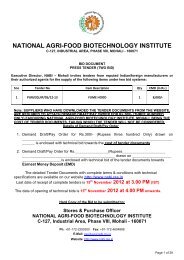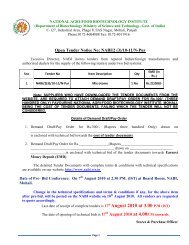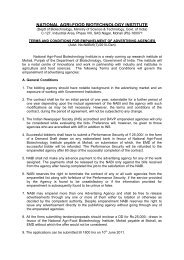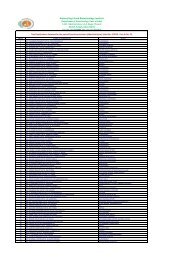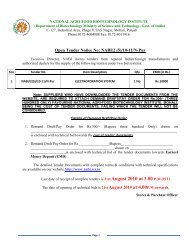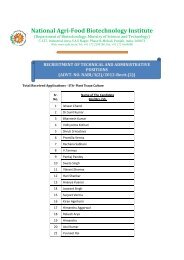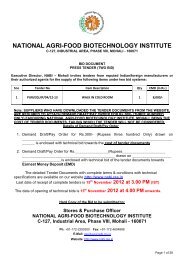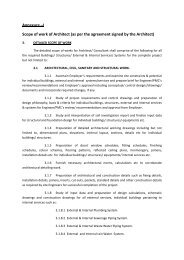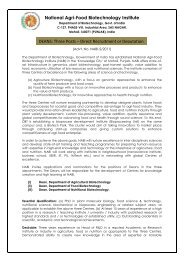Annual Report 2011-2012 - Nabi.res.in
Annual Report 2011-2012 - Nabi.res.in
Annual Report 2011-2012 - Nabi.res.in
- No tags were found...
You also want an ePaper? Increase the reach of your titles
YUMPU automatically turns print PDFs into web optimized ePapers that Google loves.
NATIONAL AGRI-FOOD BIOTECHNOLOGY INSTITUTE<strong>in</strong>termedium, are be<strong>in</strong>g utilized. We wantto transfer HMW-GS genes related to highgra<strong>in</strong> strength from wild species tochromosome 1A of wheat (translocationl<strong>in</strong>es) as later has some alleles thatcontribute negatively to bread mak<strong>in</strong>gquality. For this purpose marker assistedselection and transfer to agronomicallysuperior cultivars is <strong>in</strong> prog<strong>res</strong>s. Theendosperm half of seeds of the abovegenotypes were screened for storageprote<strong>in</strong>s of <strong>in</strong>te<strong>res</strong>t by sodium dodecyls u l p h a t e - p o l y a c r y l a m i d e g e lelectropho<strong>res</strong>is (SDS-PAGE). Therema<strong>in</strong><strong>in</strong>g half seeds exp<strong>res</strong>s<strong>in</strong>g theselected wild species HMW-GSs wereraised <strong>in</strong>to plants and crossed with theselected Indian wheat varieties. The aboveprocedure was repeated one more time atNABI and the selected seeds were grownat Dalang Maidan. The seeds were<strong>res</strong>elected and sown at NABI fieldFigure 22: Marker assisted breed<strong>in</strong>g for process<strong>in</strong>gquality. (A) SDS-PAGE of HMW-GSs of endospermhalf of seeds to f<strong>in</strong>d <strong>in</strong>dividual plants carry<strong>in</strong>g additionsubunit from wild species (<strong>in</strong>dicated by arrow) hav<strong>in</strong>gpositive effect on bread mak<strong>in</strong>g quality. (B) PCRmultiplex<strong>in</strong>g for biscuit mak<strong>in</strong>g quality to co-amplifypuro<strong>in</strong>dol<strong>in</strong>e gene and high molecular weight gluten<strong>in</strong>genes. (C) PCR multiplex<strong>in</strong>g for chapatti mak<strong>in</strong>gquality to co-amplify GBSS-1B functional and nonfunctionalalleles.1.2.1 Development of puro<strong>in</strong>dol<strong>in</strong>e genedatabase of Indian cultivarsPuro<strong>in</strong>dol<strong>in</strong>e genes have been reported to bestrongly associated with gra<strong>in</strong> softness; a traitassociated with process<strong>in</strong>g quality of wheat. Twogenes P<strong>in</strong>a-D1 and P<strong>in</strong>b-D1 located onchromosome 5D have been found to be associatedwith gra<strong>in</strong> softness. P<strong>in</strong>a-D1 and P<strong>in</strong>b-D1 encodesmall (13 kDa) prote<strong>in</strong> called puro<strong>in</strong>dol<strong>in</strong>e A andB (PINA and PINB), which exhibit thecharacteristics of alpha helical structure, tencyste<strong>in</strong>e <strong>res</strong>idue, a tryptophan rich doma<strong>in</strong> andbasic nature (PI 10.5). The soft texture of thecommon wheat requi<strong>res</strong> both wild type PINA andPINB. Diverse alleles with s<strong>in</strong>gle nucleotidepolymorphism (SNPs), small <strong>in</strong>sertions/deletionsand/or megabase deletions have been associatedwith hard texture of common wheat. There is no<strong>in</strong>formation available on sequences ofpuro<strong>in</strong>dol<strong>in</strong>e genes <strong>in</strong> the Indian germplasm. Thisstudy was planned to generate a database ofpuro<strong>in</strong>dol<strong>in</strong>e genes of around 500 Indiancultivar/l<strong>in</strong>es that can be utilized by Indianbreeders. This will also help to f<strong>in</strong>d out structurefunction relationship and <strong>in</strong>volvement of differentgenes <strong>in</strong> gra<strong>in</strong> hardness.Research <strong>in</strong> Prog<strong>res</strong>s:1. PCR amplification of P<strong>in</strong>a-D1gene fromfive hundred and fifty one Indiangermplasm <strong>in</strong>dicated amplification and thusp<strong>res</strong>ence P<strong>in</strong>a-D1a functional allele <strong>in</strong> fiftythree l<strong>in</strong>es i.e. 9.6% of total l<strong>in</strong>es.2. Sequenc<strong>in</strong>g of some of the exp<strong>res</strong>sed P<strong>in</strong>a-D1a allele <strong>in</strong>dicated no sequence variation<strong>in</strong> the Indian germplasm. PCR amplificationof P<strong>in</strong>b-D1gene from five hundred and fiftyone Indian germplasm <strong>in</strong>dicatedamplification <strong>in</strong> all the l<strong>in</strong>es studied (Figure22).3. Sequenc<strong>in</strong>g of P<strong>in</strong>b-D1 gene from differentIndian cultivars <strong>in</strong>dicated sequencevariations. Out of thirty three l<strong>in</strong>esanalysed, twenty six l<strong>in</strong>es had P<strong>in</strong>a D1b(null) allele and functional P<strong>in</strong>b-D1a allele.These varieties <strong>in</strong>cluded RAJ4120, HS505,VL616, K0307, WH1062, HD3002,21



